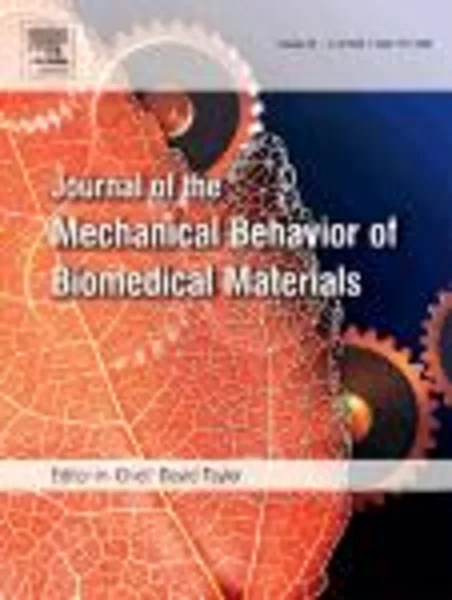-
computation of axonal elongation in head trauma finite element simulation
جزئیات بیشتر مقاله- تاریخ ارائه: 1394/01/01
- تاریخ انتشار در تی پی بین: 1394/01/01
- تعداد بازدید: 883
- تعداد پرسش و پاسخ ها: 0
- شماره تماس دبیرخانه رویداد: -
in the case of head trauma, elongation of axons is thought to result in brain damage and to lead to diffuse axonal injuries (dai). mechanical parameters have been previously proposed as dai metric. typically, brain injury parameters are expressed in terms of pressure, shearing stresses or invariants of the strain tensor. addressing axonal deformation within the brain during head impact can improve our understanding of dai mechanisms. a new technique based on directional measurements of water diffusion in soft tissue using magnetic resonance imaging (mri), called diffusion tensor imaging (dti), provides information on axonal orientation within the brain. the present study aims at coupling axonal orientation from a 12-patient-based dti 3d picture, called “dti atlas”, with the strasbourg university finite element head model (sufehm). this information is then integrated in head trauma simulation by computing axonal elongation for each finite element of the brain model in a post-processing of classical simulation results. axonal elongation was selected as computation endpoint for its strong potential as a parameter for dai prediction and location. after detailing the coupling technique between dti atlas and the head fe model, two head trauma cases presenting different dai injury levels are reconstructed and analyzed with the developed methodology as an illustration of axonal elongation computation. results show that anisotropic brain structures can be realistically implemented into an existing finite element model of the brain. the feasibility of integrating axon fiber direction information within a dedicated post-processor is also established in the context of the computation of axonal elongation. the accuracy obtained when estimating level and location of the computed axonal elongation indicates that coupling classical isotropic finite element simulation with axonal structural anisotropy is an efficient strategy. using this method, tensile elongation of the axons can be directly invoked as a mechanism for diffuse axonal injury.
مقالات جدیدترین رویدادها
-
استفاده از تحلیل اهمیت-عملکرد در ارائه الگوی مدیریت خلاقیت سازمانی و ارائه راهکار جهت بهبود
-
بررسی تاثیر ارزش وجوه نقد مازاد بر ساختار سرمایه شرکت های پذیرفته شده در بورس اوراق بهادار تهران
-
بررسی تأثیر سطح افشای ریسک بر قرارداد بدهی شرکت های پذیرفته شده در بورس اوراق بهادار تهران
-
بررسی تأثیر رتبه بندی اعتباری مبتنی بر مدل امتیاز بازار نوظهور بر نقد شوندگی سهام با تأکید بر خصوصی سازی شرکت ها
-
تأثیر آمیخته بازاریابی پوشاک ایرانی بر تصویر ذهنی مشتری پوشاک ایرانی (هاکوپیان)
-
بررسی الگوهای معماری مدارس اسلامی ایران و مدارس عالی معاصر ایران (نمونه های موردی: مدرسه چهارباغ، دارالفنون و دبیرستان البرز)
-
kinetics of monosaccharide conversion in the presence of homogeneous bronsted acids
-
characterization and dye decolorization ability of an alkaline resistant and organic solvents tolerant laccase from bacillus licheniformis ls04
-
cabs, male drivers and midnight commuting: manufacturing respectability of the unmarried women agents of call centers in india
-
the need to use rigid procedures and replace them with flexible procedures
مقالات جدیدترین ژورنال ها
-
مدیریت و بررسی افسردگی دانش آموزان دختر مقطع متوسطه دوم در دروان کرونا در شهرستان دزفول
-
مدیریت و بررسی خرد سیاسی در اندیشه ی فردوسی در ادب ایران
-
واکاوی و مدیریت توصیفی قلمدان(جاکلیدی)ضریح در موزه آستان قدس رضوی
-
بررسی تاثیر خلاقیت، دانش و انگیزه کارکنان بر پیشنهادات نوآورانه کارکنان ( مورد مطالعه: هتل های 3 و 4 ستاره استان کرمان)
-
بررسی تاثیر کیفیت سیستم های اطلاعاتی بر تصمیم گیری موفق در شرکتهای تولیدی استان اصفهان (مورد مطالعه: مدیران شرکتهای تولیدی استان اصفهان)
-
بررسی تاثیر بیش اطمینانی مدیران بر نگهداشت وجه نقد با تاکید بر نقش تعدیل کننده فرصت رشد
-
واکاوی و مدیریت نقش تعلق سازمانی در بهره وری و عملکرد کارکنان شرکت آپاداناسرام
-
بررسی تأثیر آموزش مشاوره تحصیلی گروهی بر افزایش مهارتهای تحصیلی و پیشرفت تحصیلی دانش آموزان دختر مقطع متوسطه شهر ایلام
-
بررسی اثر استراتژی تجاری شرکتها بر خطر سقوط قیمت سهام
-
investigation the deformations of shahr e bijar dam during impoundment




سوال خود را در مورد این مقاله مطرح نمایید :